 |
 |
 |
 |

Apartment Building
Rua do Teatro 156, Porto
1992 - 1995
When the the city of Porto expanded outside the medieval borders in the eighteenth century, the peripheral manors were urbanized and split into narrow and long lots,
adapting to the topography of the land. As a consequence, the houses were also conceived and built in a narrow and long shape, realized with prefabricated elements of ashlar rock,
defining the spaces and the openings. The remaining parts were usually clad with tiles on the main facade, with galvanized sheet metal at the rear and with slate blades on
the side gables. This building follows the same tradition, not for mimicry but as a concept. The stone masonry structure has been replaced by iron profiles, having maintained
the same zinc coatings and slate. Large window areas and solar protection by venetian blinds characterize the elevation to the Rua do Teatro. This fašade is occupied by the
balconies, extending the living rooms to the exterior. In relation to its neighbours, this building is relatively large. As a consequence, Eduardo Souto de Moura decided to
articulate the volume, separating it into two bodys, one of them clearly recessing from the street.
Eduardo Souto de Moura states, that changes in architecture are not as fast and obvious as it appears in the compendiums and manuals.
It is necessary to exercise designing and building to understand a dynasty as Schinkel, Leo Van Klenze, Behrens and Mies van der Rohe.
adapting to the topography of the land. As a consequence, the houses were also conceived and built in a narrow and long shape, realized with prefabricated elements of ashlar rock,
defining the spaces and the openings. The remaining parts were usually clad with tiles on the main facade, with galvanized sheet metal at the rear and with slate blades on
the side gables. This building follows the same tradition, not for mimicry but as a concept. The stone masonry structure has been replaced by iron profiles, having maintained
the same zinc coatings and slate. Large window areas and solar protection by venetian blinds characterize the elevation to the Rua do Teatro. This fašade is occupied by the
balconies, extending the living rooms to the exterior. In relation to its neighbours, this building is relatively large. As a consequence, Eduardo Souto de Moura decided to
articulate the volume, separating it into two bodys, one of them clearly recessing from the street.
Eduardo Souto de Moura states, that changes in architecture are not as fast and obvious as it appears in the compendiums and manuals.
It is necessary to exercise designing and building to understand a dynasty as Schinkel, Leo Van Klenze, Behrens and Mies van der Rohe.
